Synthetic data 101: What is it, how it works, and what it's used for
Collecting, labeling, training, and maintaining datasets for machine learning and artificial intelligence applications can be costly and time-consuming. Despite the vast amount of data produced, much of it is still inaccessible for data science and analytics projects. Strict data privacy, security, and compliance guidelines make accessing and using real-world datasets even more challenging.
As a result, organizations are turning to synthetic data, artificially generated data created using new and advanced machine learning algorithms, to provide an effective and affordable alternative to sensitive and risky real-world data. But, until recently, synthetic data generation was costly, not practical, and often required expert knowledge.
With advances in Generative AI, generating synthetic data is becoming easier and more accessible for organizations of all sizes. This guide will examine how synthetic data works, its different types, and its benefits for various applications.
Chapters
What is synthetic data?
The short answer is that synthetic data is, as the name suggests, artificial data generated to mimic real data. Typically, synthetic data is generated using sophisticated Generative AI techniques to create data similar in structure, features, and characteristics to the data found in real-world applications.
The recognition of synthetic data's importance is further highlighted by the new EU AI Act, proposed in May 2023, which explicitly mentions 'synthetic' data in Articles 10 and 54, alongside other AI-related provisions. This acknowledgment within the regulatory framework reinforces the growing importance of synthetic data and its role in various industries in which data privacy and security requirements often limit access to real-world datasets.
Since synthetic data does not have one-to-one correlations with real data, it is used for training machine learning models, testing software applications, and filling gaps in datasets when working on analytics projects. Synthetic data is vital for finance, healthcare, and insurance industries, where data privacy and security requirements limit access to real-world datasets.
How is synthetic data generated?
Synthetic data is created programmatically, with various techniques falling into three main branches: machine learning-based models, agent-based models, and hand-engineered methods.
There are several different methods for creating synthetic data with ML-based models, depending on the use case and data requirements. Some of the most common ones include:
-
Generative adversarial network (GAN) models – Synthetic data generation happens using a two-part neural network system, where one part works to generate new synthetic data and the other works to evaluate and classify the quality of that data. This approach is widely used for generating synthetic time series, images, and text data.
-
VAE (Variational Auto Encoders) - This approach uses a generative adversarial network system with an additional encoder to generate synthetic data that is highly realistic and similar in structure, features, and characteristics to real data.
-
Gaussian Copula (Statistics based) - This method uses a statistical methodology to generate realistic synthetic data with desired properties, such as being normally distributed. It is commonly used for data that has a discrete distribution, such as the probability of encountering certain events.
-
Transformer-based models - These models, such as OpenAI's GPT (Generative Pre-trained Transformer), excel at capturing intricate patterns and dependencies within the data. By training on large datasets, they learn the underlying structure and generate synthetic data that closely resembles the original distribution. Transformer-based models are extensively applied in natural language processing tasks, but they have also found applications in computer vision, speech recognition, image synthesis, music generation, and video sequence generation.
Additionally, agent-based models simulate the behavior and interactions of individual agents (entities) in a system to generate synthetic data. These models are particularly useful for scenarios where the behavior of individual entities contributes to the overall pattern observed in the data. They can include:
-
Traffic Simulation - In transportation studies, agent-based models can be used to simulate the movement of individual vehicles in a city. Each vehicle is treated as an agent with specific rules for acceleration, deceleration, and lane changes. This approach can generate synthetic traffic flow data, which is useful for testing and optimizing transportation systems.
-
Epidemiological Models - Agent-based models are frequently used in epidemiology to simulate the spread of infectious diseases. Each person in the model represents an agent, and their interactions (e.g., contact rates, infection probabilities) with other agents determine the disease transmission. Synthetic data generated through such models can help in studying the impact of interventions and predicting disease outbreaks.
-
Market Simulation - In finance, agent-based models can simulate the behavior of individual traders in a financial market. Each trader agent may have different strategies and risk preferences. By simulating their interactions and trading decisions, the model can generate synthetic financial market data, which can be used for testing trading algorithms and risk management strategies.
Hand-engineered methods involve designing rules and algorithms to generate synthetic data. These methods are often used when the underlying data distribution is well-understood and can be represented using specific mathematical or statistical models.
-
Rule-based data generation - In this approach, synthetic data is created based on a set of predefined rules and conditions. For example, let's say you have a dataset of sales transactions with customer information. To generate synthetic data, you could define rules like "create new transactions for each customer with random purchase amounts and dates, ensuring the purchase dates are within a reasonable range from the original data.”
-
Parametric models - Parametric models are mathematical representations of the data distribution, and synthetic data is generated by sampling from these models.
-
Random Sampling - In this simple approach, synthetic data is generated by randomly sampling from the existing data. For example, if you have a dataset of people's ages, you can generate synthetic data by randomly selecting ages from the original dataset.
-
Linear Interpolation - Suppose you have a dataset with time-series data points. You can use linear interpolation to generate synthetic data points between existing ones, creating a smoother time-series representation.
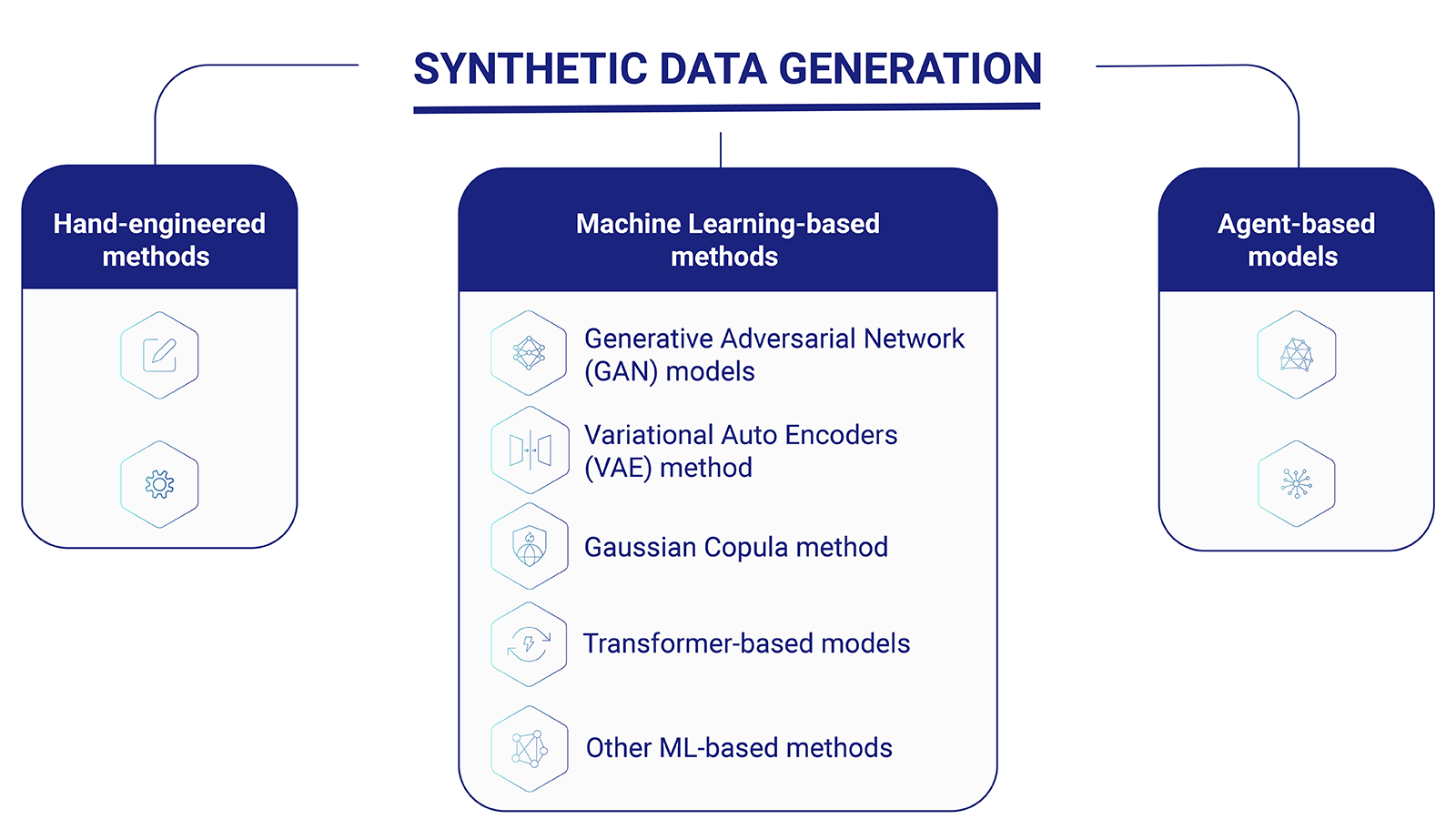
Each method has its benefits, and some algorithms can be combined to optimize synthetic data generation for specific use cases. Ultimately, the best approach will depend on your organization's needs and data requirements.
Types of synthetic data
There are a few broad types of synthetic data that serve different purposes. These include:
- Synthetic text
- Synthetic media like video, image, or sound
- Synthetic tabular data
Each of these types provides different benefits for different use cases.
For example, synthetic text is artificially-generated text data. It is often used for natural language processing and other text-related tasks where real data is unavailable or contains sensitive information.
Synthetic tabular data is generated to mimic real data for software testing or data science projects. This data is structured in rows and columns throughout relational database tables and can help organizations fill in gaps or missing values in real-world datasets.
Synthetic media, such as images or videos, are used for object detection and recognition tasks requiring real-world images or video.
Apart from the types of synthetic data mentioned above, we can also group it into three general categories based on the amount of synthetic data within each dataset:
Fully synthetic data
This type of synthetic data is entirely artificial and has no real-world equivalent. It's generated from scratch by an AI algorithm that will identify the statistical properties and patterns of the data and generate an entirely new dataset that perfectly mimics it. Datasets are generated randomly using the estimated distribution of the real dataset, with no identifiable link to real-life data.
Partially synthetic data
This type of synthetic data is partially artificial, as it contains real-world information that has been manipulated to make it unusable in a real-world scenario. It replaces sensitive information, like customer names, with generic identifiers that are impossible to trace back to the original individual.
By removing sensitive data, partially synthetic data maintains some statistical properties of real data while protecting privacy and security. The actual values with a high risk of disclosure or misuse are replaced with synthetic values that are less risky while still providing value.
Examples of techniques used to generate partially synthetic data include multiple imputation and model-based techniques. Multiple imputations involve replacing the missing data with synthetic values, and model-based techniques involve generating synthetic data based on the statistical properties of the real data.
Hybrid synthetic data
This type of synthetic data combines real-world and fully synthetic data. It includes both sensitive information and synthetic values, providing a dataset that is real enough to be valuable while protecting privacy and security. It pairs random records from the real dataset with fully synthetic ones, making it virtually impossible to trace a record back to the original individual.
Hybrid synthetic data is an excellent way for organizations to benefit from the power of real data without its risks. It allows them to scale their datasets, create advanced analytics, and develop new products informed by real customer insights while protecting their data from cyber threats.
How to determine synthetic data quality?
One of the main challenges in using synthetic data is determining its quality and accuracy. Many factors affect the quality of synthetic data, including the dataset size, the number of variables included, and how well it mimics real, actual data.
Some key considerations when evaluating the quality of synthetic data include the randomness of the sample, how well it captures the statistical distribution of real data, and whether it includes missing or erroneous values. Other factors include whether the dataset has been bootstrapped or trained on real data and whether it's been validated or tested by comparing it to actual values.
Generative models like Generative Adversarial Networks (GANS) or Variational Autoencoder (VAE) can be evaluated with metrics like Inception Score or FID score, which are used to compare the quality of synthetic data against real data. The aspects of synthetic data these metrics generally consider are similarity with training data and diversity within itself.
Another thing to consider when evaluating synthetic data quality is how well it protects data privacy and security. Different synthetic data techniques have different levels of risk when revealing sensitive information, and some are more vulnerable to cyberattacks than others.
Organizations should consider a few key factors when evaluating their synthetic data's privacy, security, and risk levels. These include how well it protects sensitive information if it is properly anonymized and de-identified and whether it could be reverse-engineered to reveal individual identities. They should also consider the probability of data leaks and hacks and whether their synthetic data techniques are robust enough to withstand tampering or attacks.
After an organization has taken the necessary measures to ensure its generated synthetic datasets are of high quality, it's important to evaluate the effectiveness of these measures. To do so, synthetic data is measured against three key dimensions: fidelity, utility, and privacy, as explained in more detail in the article “How to evaluate synthetic data quality.”
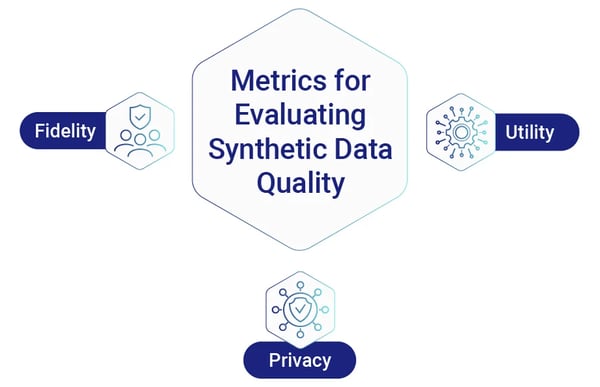
Ultimately, the quality of synthetic data depends on the specific use case and requirements. No single standard or metric can be used to evaluate its quality across all applications, especially considering the quality of certain synthetic data, such as synthetic images, is very subjective.
Synthetic data vs. real data
While real-world data is collected by real systems (such as medical tests, banking transactions, or web server logs), synthetic data is generated using machine learning algorithms.
There are several key differences between real-world and synthetic data. Real data is typically limited in size, difficult to access, and may not reflect the full range of possible values or behaviors, making it difficult to manage and analyze. In contrast, synthetic data is much more flexible, easily accessed, and generated in large quantities with greater accuracy to meet specific requirements.
Additionally, synthetic data is privacy compliant as opposed to real data, as it does not contain any personally identifiable information and can't be easily reverse-engineered to extract sensitive information.
Overall, synthetic data is a powerful tool for organizations that need access to high-quality datasets but either lacks the resources or need to keep their data private.
Synthetic data vs. dummy data
Dummy data isn't exactly dumb - quite the opposite. It's mock, fake data that acts as a placeholder for live data in development and testing. Its primary purpose is to help developers understand the functionality, logic, and flow of a system or program before the real data is available.
Synthetic and dummy data are both used during development to simulate live datasets, but they differ in several ways. Synthetic data is generated with machine learning algorithms based on real-world datasets, while developers typically create dummy data manually. Additionally, synthetic data is much more complex than dummy data and is often used to generate realistic datasets with missing or corrupted values.
Benefits of using synthetic data
Synthetic data allows organizations to leverage complex data without the added risk and privacy concerns of real-world data. Additionally, synthetic data is generated faster and more accurately than real data, making it ideal for development workflows.
Some other key benefits of using synthetic data include:
• Greater control over the quality and format of the dataset
• Lower costs associated with data management and analysis
• Better performance in machine learning algorithms due to higher-quality datasets
• Faster turnaround time for development workflows and projects
• Increased privacy and security for sensitive data sources, such as healthcare records or financial data
The benefits of synthetic data are numerous, and every organization that needs access to high-quality datasets while maintaining control over data privacy and security should consider using it for their business use cases. Whether you're a data scientist, software engineer, legal/compliance associate, or business leader, synthetic data helps you achieve your goals efficiently and in a privacy-preserving way.
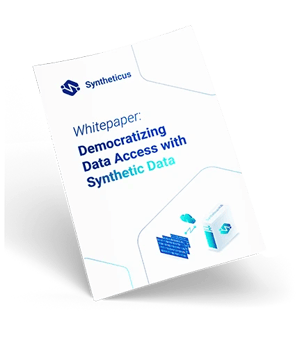
Democratizing Data Access with Synthetic Data Whitepaper
Find out how synthetic data empowers your organization to tackle data-related challenges, improve decision-making, and maintain compliance with data protection regulations.
What are the use cases for synthetic data?
Synthetic data accurately mimics real-world data. It serves as a placeholder for production data in development and testing workflows and is also used to improve the quality of machine learning algorithms. Common use cases revolve around product development/testing, machine learning, data analysis, and data privacy and security.
For example, financial institutions use synthetic data to generate reliable market data for algorithmic trading and risk analysis, while healthcare providers use it to analyze patient data without compromising sensitive patient information. Additionally, synthetic data is used in machine learning algorithms to improve performance and accuracy and thus accelerate the development process.
Synthetic data and advanced analytics
These days, corporate data is growing in number and increasingly recognized as having business value. Cloud solution providers (CSPs) offer the most effective data analytics tools, such as Google Analytics, to extract value from data within organizations. However, organizations must comply with data protection and privacy regulations that limit access to these tools.
Now public and private organizations can benefit from powerful CSP analytic tools to extract the maximum data value without breaking the isolation between their data and the CSP thanks to the joint proposition of Cysec’s leading secure OS solution with Syntheticus® privacy-preserving synthetic data capabilities.
Synthetic data and machine learning / AI
Advanced analytics refers to using big data and machine learning techniques to gain insights and make predictions about complex systems. Data scientists struggle with limited or low-quality datasets when working with machine learning, but synthetic data helps fill these gaps and enhance the accuracy of results.
Whether it's used for predictive modeling, forecasting, or financial risk management, synthetic data significantly improves the performance and results of advanced analytics systems. Additionally, it can help organizations reduce costs associated with data management, analysis, and storage.
Synthetic data and software development and testing
As software development methodologies continue to change and evolve, there is a growing need for access to realistic datasets. Synthetic data helps developers understand a system or program's functionality, logic, and flow before real data is available.
Some common use cases for synthetic data in software development include testing and debugging new features, optimizing performance, improving user experience, and creating realistic test cases. Additionally, synthetic data helps developers troubleshoot issues faster and reduce the time needed to complete development workflows.
Synthetic data and cybersecurity
Given the current climate around data privacy and security, organizations are concerned about using real-world datasets for machine learning models or sensitive applications. Synthetic data is a powerful tool to help address these concerns, allowing developers to train algorithms and create applications that comply with privacy regulations while maintaining high-performance levels.
Synthetic data also helps security teams detect, prevent, and respond to threats and malicious attacks by providing a realistic dataset for training machine learning models. By retaining the important statistical properties of real-world data and eliminating identifiable characteristics that make it easy to reverse engineer and misuse, synthetic data is used to identify and prevent fraudulent activity, ransomware attacks, and other cybersecurity threats.
Synthetic data use cases within specific industries
Many industries already leverage the potential of synthetic data. For example, financial institutions use synthetic data to generate reliable market data for algorithmic trading and risk analysis, while healthcare providers use it to analyze patient data without compromising sensitive patient information.
Synthetic data for insurance companies
Insurance companies struggle to find and access high-quality datasets for predictive modeling, pricing analysis, and risk assessment. Synthetic data helps insurance providers simulate real-world datasets and improve their predictive capabilities, allowing them to make more accurate risk assessments and price insurance policies more effectively.
In addition to improving their predictive capabilities, synthetic data helps insurance companies optimize internal workflows, evaluate new products and services, and reduce data collection and management costs. By providing a realistic dataset that mimics real-world data, synthetic datasets reduce the need to collect and store large volumes of real data while also improving the efficiency and accuracy of their models.
Use cases of synthetic data in the insurance sphere include the following:
Reinventing risk assessment
Risk assessment lies at the heart of the insurance industry, driving critical decisions that determine premiums, coverage, and overall business strategies. However, traditional risk assessment methods often fall short of capturing the complexities of the modern world.
Unlike conventional data collection, limited by historical data or specific demographics, synthetic data is tailored to include various risk factors and demographic variables. This enables insurers to make more accurate risk predictions and better understand potential outcomes.
Another significant advantage of synthetic data in risk assessment is its ability to account for extreme or rare events. In the real world, certain events may occur infrequently but have a significant impact when they do. With synthetic data, insurers simulate these rare occurrences and assess their potential consequences, allowing them to develop more robust risk models.
Reshaping claims processing
Claims processing is another critical function for insurance companies, as it directly impacts customer satisfaction and operational efficiency. Traditionally, claims processing has been a labor-intensive and time-consuming process, often prone to errors and delays.
One of the key benefits of using synthetic data in claims processing is the ability to create realistic and diverse datasets that represent various types of claims. It allows insurers to simulate different scenarios, from routine claims to complex and rare events. Additionally, it accelerates the claims processing timeline, leading to faster and more efficient service for policyholders.
Detecting fraud deception
If anything results in substantial financial losses and damage to an insurer's reputation, it is fraud. Detecting and preventing fraud requires advanced techniques and robust algorithms, exactly what synthetic data provides.
It offers a unique advantage in fraud detection by allowing insurers to create realistic and diverse fraud scenarios. Fraudsters continuously evolve their tactics to evade detection, making it challenging for traditional fraud detection methods to keep up.
Another crucial advantage of using synthetic data for fraud detection goes back again to its ability to safeguard customer privacy. Fraud detection algorithms require access to sensitive data, making privacy protection a significant concern. Synthetic data provides a privacy-compliant solution by generating data containing no customer information, ensuring individual privacy is upheld throughout the fraud detection process.
Software testing with synthetic data
Using personal data in development and testing environments has become a significant concern, especially in light of stringent privacy regulations like GDPR, CPRA, and ISO 27001, including its newest version from 2022. In the past, developers often used real customer data to test new features and identify bugs. However, with more stringent privacy regulations, this leads to significant privacy risks.
Another issue worth mentioning when discussing software testing is the challenges associated with hiring and retaining technical talent. According to a 2023 Gartner survey of software engineering leaders, talent hiring, development, and retention are the top challenges they currently face.
This emphasizes the importance of improving test data management (TDM) practices to alleviate the burden on product teams and enhance software testing processes. Synthetic data offers a new approach to TDM, allowing insurance companies to avoid the challenges of utilizing production data for testing purposes.
Embracing inclusivity: Combating bias
As data-driven decision-making becomes increasingly prevalent, the insurance industry is less of a stranger to discrimination. Exclusionary underwriting practices and bias in data-driven applications can lead to unfavorable outcomes for specific groups.
Bias in AI algorithms has far-reaching implications for insurers and their customers, leading to unfair treatment and higher premiums for certain customer groups and inadequate coverage for others. Unlike real-world data, synthetic data is artificially generated with precision and tailored to include diverse demographics, ensuring fair and accurate representations of various customer groups.
Synthetic data in banking and finance companies
Banks and financial institutions face various challenges using real-world data in their operations. Some of the biggest issues they face include the high cost of data collection and management, the limited availability of high-quality datasets, and regulatory risks around data privacy.
If we add growing cybersecurity concerns, money laundering, and restricted access to transaction data to the mix, banks and financial institutions face significant challenges with using real-world data in their operations.
However, synthetic data is changing the game for financial institutions by offering a solution to overcome usage limitations, privacy concerns, and security risks. Synthetic data provides realistic datasets that allow organizations to train machine learning models, evaluate new products and services, and improve operations without exposing sensitive customer information.
The use cases of synthetic data are extensive across various finance domains, including:
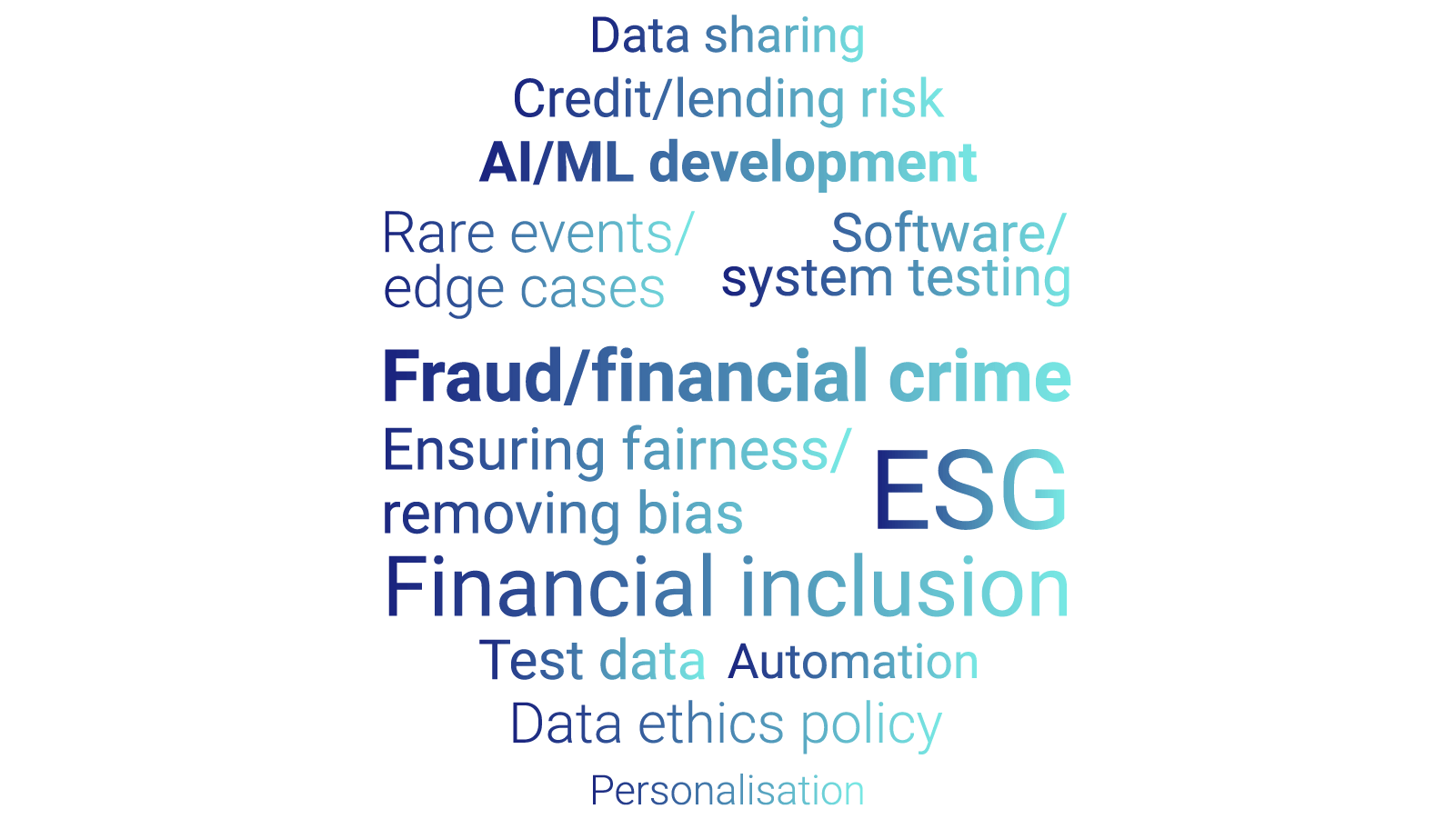
Anti-money laundering (AML)
Money laundering is a significant concern for financial institutions, and AML models play a critical role in detecting suspicious activity. Synthetic data generates large sets of synthetic transactions, enabling organizations to train and test their AML models more accurately. It helps identify potential accounts, transactions, payments, and withdrawals or purchases, allowing institutions to hone their AML models and stay ahead of new criminal tactics.
Fraud detection and risk management
By generating synthetic data that mimics real-world fraud patterns, institutions improve their fraud detection models and reduce the number of false positives. Synthetic data helps banks simulate different risk scenarios to fine-tune their risk management strategies and ensure they are operating at optimal levels.
Data bias reduction
Data bias is one of the challenges of using real-world data, leading to models that perpetuate this bias. Synthetic data helps reduce the risk of data being used to perpetuate prejudices by creating datasets more representative of the entire population, including underrepresented groups.
Credit scoring and loan origination
Synthetic data generates digital twins of customers and simulates their credit scores, enabling lenders to make more accurate loan origination decisions. By simulating a broad range of scenarios and borrower characteristics and behaviors, institutions will better understand the creditworthiness of their clients, leading to more accurate credit decisions and better risk management.
Portfolio optimization
Portfolio optimization is the process of selecting the optimal mix of investments to achieve a specific financial objective. Synthetic data helps institutions generate vast amounts of data on different investment scenarios and evaluate the performance of various portfolios. This helps them identify the most profitable and efficient portfolios, leading to better returns for their clients.
Stress testing and scenario analysis
Synthetic financial data is especially useful for stress testing and scenario analysis. This involves creating hypothetical scenarios and simulating how a portfolio or financial instrument would perform under those conditions. Synthetic data enables institutions to generate a diverse range of scenarios that are difficult or impossible to obtain from real-world data, allowing them to test the robustness of their models and prepare for a range of potential market conditions.
Synthetic data in healthcare and pharma
To improve research and development workflows, healthcare organizations rely on large-scale datasets to create personalized medicine, improve drug discovery capabilities, and perform predictive analytics. However, due to privacy regulations and data ownership concerns, researchers struggle to access accurate datasets for running clinical trials, developing new medical treatments, and improving patient outcomes.
Synthetic data offers a compelling solution to these challenges, allowing healthcare and pharma companies to create realistic datasets to train and evaluate machine learning models without compromising the confidentiality of patient information. It provides a fast and cost-effective way to model real-world data and optimize workflows while minimizing risk and maintaining compliance with privacy regulations.
In the healthcare and pharma industries, various data types are generated using synthetic data generation techniques. Image data, such as medical imaging scans, has been at the forefront of medical advancements, enabling more accurate diagnoses and AI-powered surgical guidance systems.
However, the potential of artificial intelligence extends beyond image analysis. While they have been essential for medical advancements, other data types, such as tabular healthcare data (electronic health records, lab results, etc.), also hold great value for AI applications in healthcare.
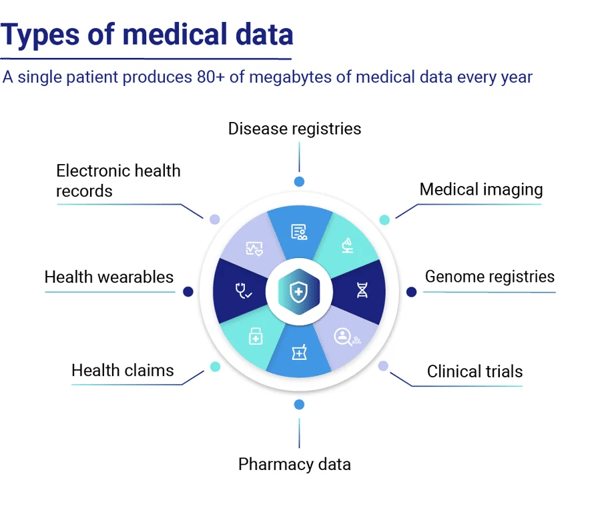
Source: Huesch, D., and Mosher, T. J. (2017). Using It or Losing It? The Case for Data Scientists Inside Health Care. NeJM Catalyst. Available online at: https://catalyst.nejm.org/case-data-scientists-inside-health-care/
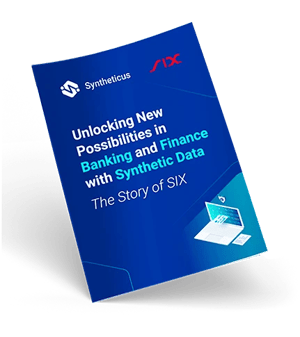
Unlocking New Possibilities in Banking and Finance with Synthetic Data: The Story of SIX - Case Study
Learn how SIX AG leveraged Syntheticus to generate accurate and diverse data for improved decision-making and reduced risk in the banking and finance industry.
Tips for working with synthetic data
Whether you are using synthetic data for predictive modeling, fraud detection, or cybersecurity applications, there are a few key tips to keep in mind when working with it.
Work with clean initial data
Start with clean and well-structured data, which is the foundation for building accurate synthetic datasets. Clean or reconcile your data first to ensure that it is of high quality and will perform well when you start building your synthetic dataset.
Make sure the data you are using is high-quality and realistic, with all the statistical properties of real-world data. This will ensure that your models are accurate and reliable and help you improve operational efficiency and reduce costs.
Optimize for realistic scenarios
In addition to clean and well-structured data, make sure that the synthetic dataset you are building contains realistic scenarios or use cases. This will ensure that your data models and training datasets are as accurate and effective as possible.
Test your results thoroughly
When using synthetic data for machine learning or predictive modeling applications, it is important to thoroughly test and verify your models' accuracy. This can be done manually by comparing your results against real data or automatically using statistical testing tools to highlight any discrepancies. Syntheticus platform comes equipped with a data validation tool that allows you to test and refine your synthetic data before and during model training, ensuring optimal performance.
Consider regulatory requirements, privacy laws, and cybersecurity concerns
If your real data relates to sensitive information such as customer data, health records, or financial transactions, it is important to consider any regulatory requirements and concerns around privacy and cybersecurity. Keep a close eye on relevant data privacy laws and regulations, such as the General Data Protection Regulation (GDPR) or California Consumer Privacy Act (CCPA), to ensure that your synthetic data projects comply with privacy requirements.
Moreover, the newly introduced Privacy Enhancing Technology Research Act (H.R.4755) highlights the importance of privacy-enhancing technologies (PETs) and aims to accelerate their development, deployment, and adoption across various industries. Integrating PETs like synthetic data into your data collection and analytics processes can help enhance privacy protections and facilitate responsible data use.
Where to get synthetic data?
When it comes to generating high-quality synthetic data for your next project, you will find a variety of options available, depending on your needs and budget.
Commercial vendors' software platforms and frameworks, such as Syntheticus, seamlessly plug into your existing data infrastructure and enable you to quickly generate realistic synthetic datasets for training machine learning models or performing predictive analytics.
Another thing to consider when choosing a synthetic data provider is the level of support you will receive. The best vendors offer a range of services, from consulting and training to expert guidance on setting up and optimizing your synthetic data projects.
They usually provide some privacy and compliance guarantee, as well, to give you peace of mind knowing that your synthetic data is safe and compliant. Some come with free trials or plans for small datasets, so you can try out the tool and see how it works before committing to an entire project.
Open-source tools and libraries offer code and algorithms you can use and modify to build your own custom synthetic datasets, ideal for researchers or developers who want more control over their data.
Open-source solutions are free and available to anyone, with community support and a wealth of online resources, making them an attractive choice for developers or researchers on a budget. However, they may not always be as easy to use or fully customizable as commercial solutions.
Ready to Explore the Power of Synthetic Data?
Sign up for a free demo and learn how synthetic data advances your data-driven projects to achieve better business results.